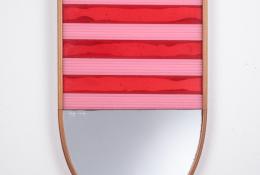Specchi Veneziani at Design Miami/Basel 2022
Caterina Tognon is happy to announce the participation in the 2022 edition of Design Miami/Basel,
presenting a unique series of mirror prototypes, designed by Wendy Wheatley and Marco Zanini and produced in 1990 by S.A.L.I.R. in Murano, Venezia.
The historical company S.A.L.I.R. – Studio Ars et Labor Industrie Riunite was founded in 1922 by Decio Toso and Giuseppe D’Alpaos in Murano, with the dual aim of recovering particular aspects of the Muranese tradition linked to the production and decoration of mirrors, and seeking new artistic and technological solutions. It worked with personalities such as Franz Pelzel, Guido Balsamo Stella, Vittorio Zecchin, Tono Zancanaro, Vinicio Vinello, Giò Ponti, Giorgio De Chirico.
Sons of the founders, Mario D'Alpaos and Luigi (Gigi) Toso have been owners since the 70s, promoting a fruitful relationship with numerous artists and designers including Riccardo Licata, Agostino Venturini, Ettore Sottsass, Fulvio Bianconi, Vincenzo Eulisse, Marco Zanini, Wendy Wheatley, Renato Guttuso, exhibiting at many national and international exhibitions and obtaining various prizes and awards.
S.A.L.I.R. closed its doors in 2020.
The series Specchi Veneziani was designed in 1990 by Wendy Wheatley (b. 1962 in Hartford, Connecticut, USA. Lived and works in Milan) and Marco Zanini (b. 1954 in Trento, Italy. Lives and works in Rio de Janeiro, Brazil) under request of S.A.L.I.R., at a time when the two designers were working respectively as assistant and partner of Studio Sottsass Associati, and part of the Memphis design collective.
They designed 10 mirrors each, with a very different artistic inspiration.
In 1990, just after the prototyping of 10 mirrors designed by Marco Zanini and 10 designed by Wendy Wheatley, the collection was photographed by Santi Caleca for a dedicated catalog, and exhibited by Mario Godani at the Design Gallery in Via Manzoni in Milano.
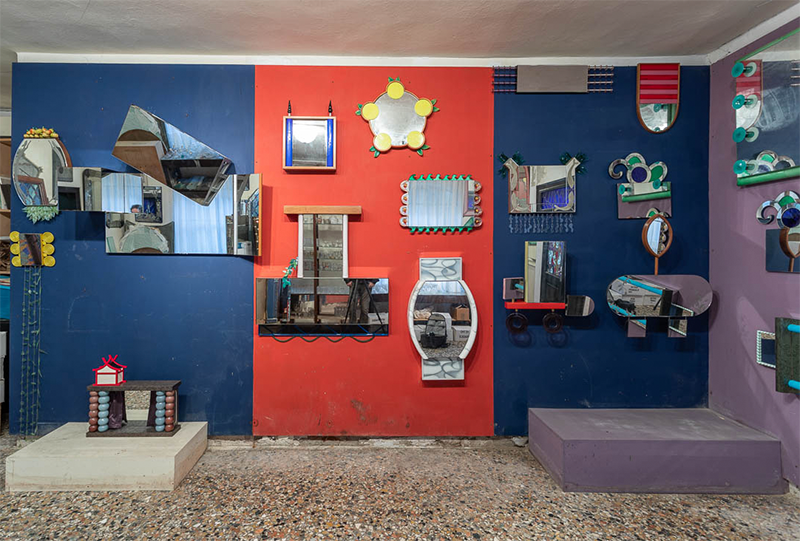
Memphis Milano is an unstructured movement born in 1980 and destined to revolutionize the history of design, despite its short life (it will remain active until 1987).
Its protagonists include, in addition to mentor Ettore Sottsass and his wife Barbara Radice, the designers Aldo Cibic, Matteo Thun, Marco Zanini, Martine Bedin, Michele De Lucchi, Nathalie Du Pasquier, George Sowden, Ernesto Gismondi (president of Artemide, recently passed away), to which many others are added, such as Alessandro Mendini, Andrea Branzi, Michael Graves, Hans Hollein, Arata Isozaki, Shiro Kuramata and Javier Mariscal.
The first collection was presented in 1981 at the Salone del Mobile in Milano, in the Arc '74 showroom of Brunella and Mario Godani, and gained immediate International acclaim.
From the beginning, the programmatic goal of the movement has been to break the rules of so-called 'good taste', playing with elements of kitsch, pop culture, advertising, non-Western cultures –- to name just a few of its very heterogeneous influences. Nonetheless, Memphis' works were anything but casual or simply anarchic: meticulously composed, they resulted in a new type of elegance, cutting and postmodern, even provocative, which mirrored the world of media and globalization and was characterized by an explosion of colors, patterns and fantastic shapes.
Memphis reflected the spirit of the 80s, the fast-paced and sometimes contradictory world of its time: a world of advertising and consumerism in which the boundary between 'high' and 'popular' culture no longer existed. Leaving behind the politicized trends of the 60s and 70s, it celebrated a more hedonistic lifestyle and the desire to overcome the dogma of Modernism, reviving the notion of ornament, albeit without rejecting functionalism recognizing rather that the message of an object is also a part of its function. This idea in particular had a huge influence on later design, as it freed designers from the simple design function, turning it into actual storytelling.
It was also the first design movement to reflect the revolutionary influence of electronic media on design itself.
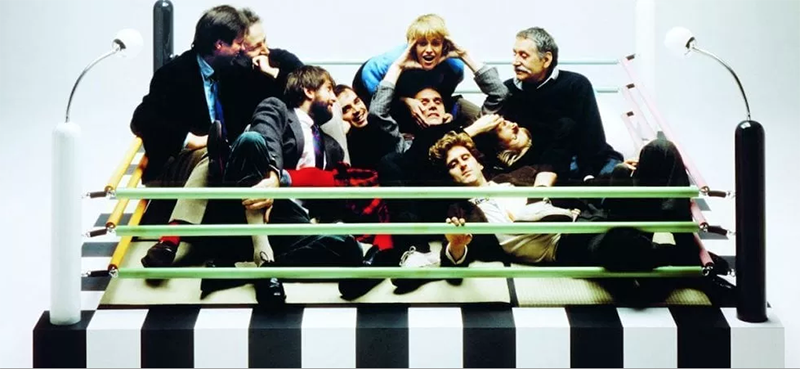

Wendy Wheatley
Angastera
Unique Piece, S.A.L.I.R. Murano, Venezia, 1990
Specchio con quattro pesci incisi, pendagli bisellati di cristallo trasparente ed alghe di vetro verde. Mirror featuring four engraved fish, two rows of bevelled glass pendants and green glass seaweed.
h 67 x 70 x 4 cm
ph: Francesco Allegretto
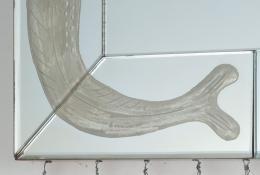
Wendy Wheatley
Angastera
Unique Piece, S.A.L.I.R. Murano, Venezia, 1990
Specchio con quattro pesci incisi, pendagli bisellati di cristallo trasparente ed alghe di vetro verde. Mirror featuring four engraved fish, two rows of bevelled glass pendants and green glass seaweed.
h 67 x 70 x 4 cm
ph: Francesco Allegretto

Marco Zanini
Anzinello
Unique Piece, S.A.L.I.R. Murano, Venezia 1990
Specchio luminoso, con cornice girevole in legno di pero e due specchietti appesi.
Lo specchio grande è inciso con un decoro a foglie incise a sabbia.
Lighted mirror, with a smaller rotating part on top in a pear wood frame. Two small mirrors are hung from the bottom. The big mirror is decorated with a sandblasted foliage décor.
h 90 x 76 x 15 cm
ph: Francesco Allegretto

Marco Zanini
Anzinello
Unique Piece, S.A.L.I.R. Murano, Venezia 1990
Specchio luminoso, con cornice girevole in legno di pero e due specchietti appesi.
Lo specchio grande è inciso con un decoro a foglie incise a sabbia.
Lighted mirror, with a smaller rotating part on top in a pear wood frame. Two small mirrors are hung from the bottom. The big mirror is decorated with a sandblasted foliage décor.
h 90 x 76 x 15 cm
ph: Francesco Allegretto

Marco Zanini
Averlino
Unique Piece, S.A.L.I.R. Murano, Venezia 1990
Specchio con mensola in marmo macchiavecchia e colonnine in legno di pero. Incisioni sabbiate a onde e testo “People of the world unite”.
Mirror with marble shelf and pear wood columns. Sandblasted serpentine décor and engraved text “People of the world unite”.
h 100 x 68 x 8 cm
ph: Francesco Allegretto
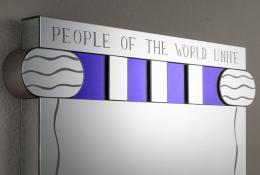
Marco Zanini
Averlino
Unique Piece, S.A.L.I.R. Murano, Venezia 1990
Specchio con mensola in marmo macchiavecchia e colonnine in legno di pero. Incisioni sabbiate a onde e testo “People of the world unite”.
Mirror with marble shelf and pear wood columns. Sandblasted serpentine décor and engraved text “People of the world unite”.
h 100 x 68 x 8 cm
ph: Francesco Allegretto

Marco Zanini
Cesendello
Unique Piece, S.A.L.I.R. Murano, Venezia 1990
Specchio da tavolo con cornice in legno di pero e due colonnine di vetro rosa. Decorato con due cipressi in vetro.
Tabletop mirror in a pear wood frame with two glass columns and two small glass cypress trees on top.
h 55 x 40 x 8 cm
ph: Francesco Allegretto

Marco Zanini
Cesendello
Unique Piece, S.A.L.I.R. Murano, Venezia 1990
Specchio da tavolo con cornice in legno di pero e due colonnine di vetro rosa. Decorato con due cipressi in vetro.
Tabletop mirror in a pear wood frame with two glass columns and two small glass cypress trees on top.
h 55 x 40 x 8 cm
ph: Francesco Allegretto

Wendy Wheatley
Fiolario
Unique Piece, S.A.L.I.R. Murano, Venezia 1990
Specchio con lati curvi e con due animali incisi a sabbia. Decorato con zucche e foglie di vetro.
Mirror with curved sides and two sandblasted running animals. The top is decorated with glass pumpkins and the bottom with glass leaves.
h 80 x 45 x 6 cm
ph: Francesco Allegretto

Wendy Wheatley
Fiolario
Unique Piece, S.A.L.I.R. Murano, Venezia 1990
Specchio con lati curvi e con due animali incisi a sabbia. Decorato con zucche e foglie di vetro.
Mirror with curved sides and two sandblasted running animals. The top is decorated with glass pumpkins and the bottom with glass leaves.
h 80 x 45 x 6 cm
ph: Francesco Allegretto

Wendy Wheatley
Gialdolin
Unique Piece, S.A.L.I.R. Murano, Venezia 1990
Specchio tondo con 5 dischi di vetro giallo in rilievo. Cornice di legno decorato con foglie di vetro.
Round mirror appliqued with 5 yellow glass disks and wooden frame decorated with glass leaves.
Ø 60 cm x 5 cm
ph: Francesco Allegretto

Wendy Wheatley
Gialdolin
Unique Piece, S.A.L.I.R. Murano, Venezia 1990
Specchio tondo con 5 dischi di vetro giallo in rilievo. Cornice di legno decorato con foglie di vetro.
Round mirror appliqued with 5 yellow glass disks and wooden frame decorated with glass leaves.
Ø 60 cm x 5 cm
ph: Francesco Allegretto

Marco Zanini
Moiolo
Unique Piece, S.A.L.I.R. Murano, Venezia 1990
Specchio con due mezzo colonnine di legno verde e elementi di vetro azzurro.
Piccoli specchi laterali incorniciati da canna di vetro bianco, verde, e viola “zanfirico”.
Mirror with two green wooden half-columns and two blue glass elements.
On each side there is a small mirror framed with white, green and purple “zanfirico” glass rod.
h 46 x 140 x 11,5 cm
ph: Francesco Allegretto

Marco Zanini
Moiolo
Unique Piece, S.A.L.I.R. Murano, Venezia 1990
Specchio con due mezzo colonnine di legno verde e elementi di vetro azzurro.
Piccoli specchi laterali incorniciati da canna di vetro bianco, verde, e viola “zanfirico”.
Mirror with two green wooden half-columns and two blue glass elements.
On each side there is a small mirror framed with white, green and purple “zanfirico” glass rod.
h 46 x 140 x 11,5 cm
ph: Francesco Allegretto

Marco Zanini
Moretto
Unique Piece, S.A.L.I.R. Murano, Venezia 1990
Specchio con fasce curve in marmo bianco statuario. Decorato con due vetri dipinti incorniciati da canna di vetro bianco.
Mirror with curved white marble sides. Decorated with two airbrushed plates of glass framed by white glass rod. h 93 x 51 x 13 cm
ph: Francesco Allegretto

Marco Zanini
Moretto
Unique Piece, S.A.L.I.R. Murano, Venezia 1990
Specchio con fasce curve in marmo bianco statuario. Decorato con due vetri dipinti incorniciati da canna di vetro bianco.
Mirror with curved white marble sides. Decorated with two airbrushed plates of glass framed by white glass rod. h 93 x 51 x 13 cm
ph: Francesco Allegretto

Wendy Wheatley
Perler
Unique Piece, S.A.L.I.R. Murano, Venezia 1990
Specchio rettangolare con supporto di legno nero. I due lati hanno quattro bastoni con dischi di vetro colorato. Rectangular mirror with black wood backing. Two sides have four horizontal rods beaded colored glass disks.
h 21 x 93 x 5 cm
ph: Francesco Allegretto

Wendy Wheatley
Perler
Unique Piece, S.A.L.I.R. Murano, Venezia 1990
Specchio rettangolare con supporto di legno nero. I due lati hanno quattro bastoni con dischi di vetro colorato. Rectangular mirror with black wood backing. Two sides have four horizontal rods beaded colored glass disks.
h 21 x 93 x 5 cm
ph: Francesco Allegretto
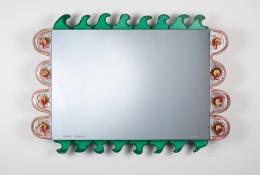
Wendy Wheatley
Puliga
Unique Piece, S.A.L.I.R. Murano, Venezia 1990
Specchio rettangolare con bordi decorati in vetro colorato tagliato ad onda, canna di vetro e fiori.
Rectangular mirror featuring sides decorated with cut green glass waves, undulated glass rod and glass flowers.
h 45 x 62 x 6 cm
ph: Francesco Allegretto
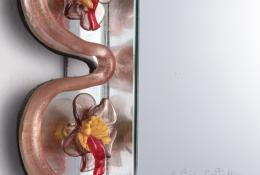
Wendy Wheatley
Puliga
Unique Piece, S.A.L.I.R. Murano, Venezia 1990
Specchio rettangolare con bordi decorati in vetro colorato tagliato ad onda, canna di vetro e fiori.
Rectangular mirror featuring sides decorated with cut green glass waves, undulated glass rod and glass flowers.
h 45 x 62 x 6 cm
ph: Francesco Allegretto

Wendy Wheatley
Rabico
Unique Piece, S.A.L.I.R. Murano, Venezia 1990
Piccolo specchio con spirali in vetro giallo ai due lati e quattro fili lunghi di seta con foglie di vetro infilate.
Small mirror with yellow glass coils at both sides and four long trailing silk strings full of green glass leaves.
h 120 x 32 x 13 cm
ph: Francesco Allegretto

Wendy Wheatley
Rabico
Unique Piece, S.A.L.I.R. Murano, Venezia 1990
Piccolo specchio con spirali in vetro giallo ai due lati e quattro fili lunghi di seta con foglie di vetro infilate.
Small mirror with yellow glass coils at both sides and four long trailing silk strings full of green glass leaves.
h 120 x 32 x 13 cm
ph: Francesco Allegretto

Marco Zanini
Zaffaro
Unique Piece, S.A.L.I.R. Murano, Venezia 1990
Specchio da tavolo con sipario in seta cangiante viola e 4 colonnine di vetro viola e grigio; struttura in legno grigio scuro.
È decorato con una piccola pagoda laccata in rosso, bianco e nero.
Self-standing mirror with purple silk curtain and four grey and purple glass columns. Frame structure veneered with dark grey briarwood. Decorated by a small red, white and black lacquered pagoda that sits on top.
h 60 x 65 x 14 cm
ph: Francesco Allegretto

Marco Zanini
Zaffaro
Unique Piece, S.A.L.I.R. Murano, Venezia 1990
Specchio da tavolo con sipario in seta cangiante viola e 4 colonnine di vetro viola e grigio; struttura in legno grigio scuro.
È decorato con una piccola pagoda laccata in rosso, bianco e nero.
Self-standing mirror with purple silk curtain and four grey and purple glass columns. Frame structure veneered with dark grey briarwood. Decorated by a small red, white and black lacquered pagoda that sits on top.
h 60 x 65 x 14 cm
ph: Francesco Allegretto

Marco Zanini
Zembola
Unique Piece, S.A.L.I.R. Murano, Venezia 1990
Specchio a due volumi girevoli e struttura in metallo laccato rosso. Lo spessore degli specchi è in vetro colorato, dischi di vetro viola appesi.
Mirror with two rotating parts on a red lacquered metal structure. Hanging from the edge are two purple glass disks. The sides of the mirrors are made of colored glass.
h 67 x 67 x 16 cm
ph: Francesco Allegretto

Marco Zanini
Zembola
Unique Piece, S.A.L.I.R. Murano, Venezia 1990
Specchio a due volumi girevoli e struttura in metallo laccato rosso. Lo spessore degli specchi è in vetro colorato, dischi di vetro viola appesi.
Mirror with two rotating parts on a red lacquered metal structure. Hanging from the edge are two purple glass disks. The sides of the mirrors are made of colored glass.
h 67 x 67 x 16 cm
ph: Francesco Allegretto

Marco Zanini
Zenabrio
Unique Piece, S.A.L.I.R. Murano, Venezia 1990
Specchio in due elementi con colonnine luminose di vetro rosa. Il piano superiore è il legno di pero. Decorato con foglie e canna di vetro verde e azzurro.
Mirror in two parts with lighted pink glass columns. The top piece is made of pear wood. Decorated with glass leaves and green and blue rod.
h 100 x 106 x 10 cm
ph: Francesco Allegretto

Marco Zanini
Zenabrio
Unique Piece, S.A.L.I.R. Murano, Venezia 1990
Specchio in due elementi con colonnine luminose di vetro rosa. Il piano superiore è il legno di pero. Decorato con foglie e canna di vetro verde e azzurro.
Mirror in two parts with lighted pink glass columns. The top piece is made of pear wood. Decorated with glass leaves and green and blue rod.
h 100 x 106 x 10 cm
ph: Francesco Allegretto




